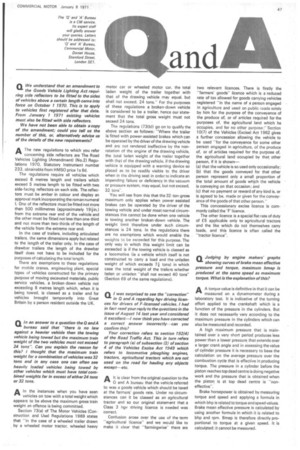n I was surprised to see the "correction"
Page 49

If you've noticed an error in this article please click here to report it so we can fix it.
in Q and A regarding hgv driving licences for drivers of F-licensed vehicles. I had in fact read your reply to the questions in the issue of August 14 last year and considered it excellent—I now think you have corrected a correct answer incorrectly—can you confirm this?
Your correction refers to section 192(4) of the Road Traffic Act. This in turn refers to paragraph (a) of subsection (2) of section 4 of the Vehicles Excise Act 1949 which refers to locomotive ploughing engines, tractors, agricultural tractors which are not used on the road for hauling any objects except—etc.
AIt is clear from the original question to the
Q and A bureau that the vehicle referred to was a goods vehicle which should be taxed at the farmers' goods rate. Under no circumstances can it be classed as an agricultural tractor and so our original statement that a Class 3 hgv driving licence is needed was correct.
Confusion arose over the use of the tem-i "agricultural licence" and we would like to make it clear that "farmingwise" there are two relevant licences. There is firstly the "farmers' goods" licence which is a reduced rate of tax allowed for goods carrying vehicles registered "in the name of a person engaged in agriculture and used on public roads solely by him for the purpose of the conveyance of the produce of, or of articles required for the purposes of, the agricultural land which he occupies, and for no other purpose:" Section 10(7) of the Vehicles (Excise) Act 1962 gives a further concession allowing the vehicle to be used "for the conveyance for some other person engaged in agriculture, of the produce of, or of articles required for the purpose of, the agricultural land occupied by that other person, if it is shown—
(a) that the vehicle is so used only occasionally; (b) that the goods conveyed for that other person represent only a small proportion of the total amount of goods whi,ch the vehicle is conveying on that occasion; and (c) that no payment or reward of any kind is, or is agreed to be, made or given for the conveyance of the goods of that other person."
This concessionary excise licence is commonly called the 'F' licence.
The other licence is a special flat rate of duty of £5 applicable only to agricultural tractors and the like which do not themselves carry loads, and this licence is often called the "tractor licence".












































































































































